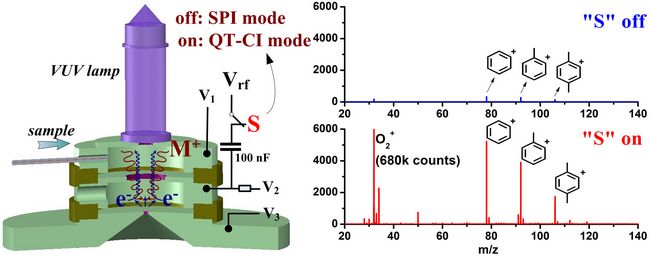Recently, Prof. LI Haiyanget al. from DICP have developed a new quasi-trapping chemical ionization (QT-CI) source based on a commercial VUV Kr lamp and a radiofrequency electric field. The accomplishment was published in the Analytical Chemistry.
(http://pubs.acs.org/doi/pdf/10.1021/ac403132k)
Ion source which could be used to ionize neutral molecule, is one of core component in mass spectrometry and ion mobility spectrometry. In recent years, soft ionization is becoming an attractive soft ionization method due to its high molecular ions yield and simple spectrum interpretation. Single photon ionization based on a VUV lamp a classic soft ionization is compact and low cost. However, there are still two apparent disadvantages of the VUV lampleading to low sensitivity and limited range of ionizable molecules, such as relatively low photon flux (1011 photons/s) and fixed photon energy (10.6 eV),.
The mechanisms of QT-CI source include: accelerating the photoelectrons originated from the photoelectric effect with VUV light to trigger the chemical ionization through ion-molecule reaction and increasing the collisions between reactant ion O2+ and analyte molecules to enhance the efficiency of chemical ionization. Compared to single SPI based on VUV krypton lamp, the QT-CI source can not only apparently improve the sensitivity (e.g., 12-118 fold enhancement were achieved for 13 molecules, including aromatic hydrocarbon, chlorinated hydrocarbon, hydrogen sulfide, etc.) but also extend the range of ionizable molecules with ionization potential higher than 10.6 eV, such as propane, dichloroethane and trichloromethane.
The development of QT-CI source is a breakthrough based on the previous works of new ion source. (Anal. Chem. 2011, 83, 8892, Anal. Chem. 2011, 83:5309-16) and SPI-CI composite ion source.(Text by HOU Keyong/ Photo by CHEN Ping)
